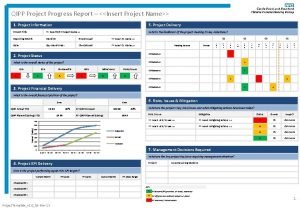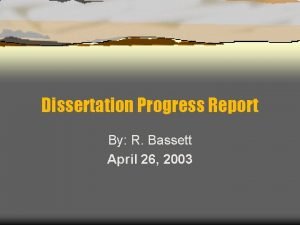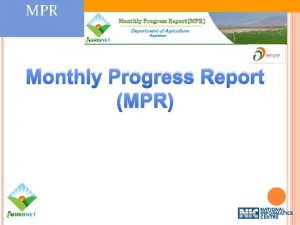Na SHC Meeting Korea April 2016 Progress Report

















- Slides: 17

Na. SHC Meeting Korea April 2016 Progress Report Dr Alistair Holdsworth

Background Project Plan • Synthesis and characterisation • Process optimisation and scaleup • Testing and verification • Performance analysis with daughter nuclei • Preparation of composites • Performance analysis of composites • Disposal • Recyclability • Vitrification and stability

Background Project Plan • Synthesis and characterisation • Process optimisation and scaleup • Testing and verification • Performance analysis with daughter nuclei • Preparation of composites • Performance analysis of composites • Disposal • Recyclability • Vitrification and stability

Background Metal Phosphates • AMPO 4, AMP 2 O 7 and A 2 M(PO 4)2 • A = NH 4, K, M = divalent, trivalent or tetravalent metal respectively • Selectivity • Similar systems demonstrate selectivity for Cs and Sr 1 -4 • Plate-like or mesoporous structures • Capacity • Theoretical capacities up to near parity (970 mg/g Cs) • Cost • Inexpensive commodity precursors • Ease of Preparation • Facile one-step synthesis, quantitative yield • Stability • Insoluble • Readily vitrified into a glassy form • Novelity • Received very little attention to date References 1) E. H. Borai et al, IAEA Report, 2008 2) L. Campao, Ph. D Thesis, 2003 3) N. P Dikiy, NSC, Ukraine, 2015 4) V. A. Burnell, Ph. D Thesis, 2011

Background Continuous Flow Synthesis • Advantages over batch: • Reproducibility • Batch to batch variation • High throughput capable • Short reaction time • Very adaptable (engineering) • Modularity • Supports a wide range of chemistries • Scalable (mg to kg in lab) • Material properties tunable • Particle size, crystallinity, phase, etc. • Rapid and scalable preparation of nanomaterials

Hydroxyapatite Ca 5(PO 4)3 OH XRD SEM

Calcium H-Phosphate (Brushite) – Ca. HPO 4 XRD SEM

Magnesium H-Phosphate Mg. HPO 4 XRD SEM

Tin (II) H-Phosphate Sn. HPO 4 XRD SEM

Cancrinite Na 6 Al 6 Si 6 O 24. Na. OH XRD SEM

Ammonium Mn Phosphate NH 4 Mn. PO 4 XRD SEM

Ammonium Fe Phosphate NH 4 Fe. PO 4 XRD SEM

Ammonium Co Phosphate NH 4 Co. PO 4 XRD SEM

Ammonium Ni Phosphate NH 4 Ni. PO 4 XRD SEM

Ammonium Zn Phosphate NH 4 Zn. PO 4 XRD SEM

Ion Exchange Testing • Ion exchange screening done using 0. 25 g of each compound in 25 ml of Cs, Sr or both in solution: • 4 ppm Cs, 2. 7 ppm Sr • Shaken overnight, allowed to settle. • Cs and Sr uptake analysed using ICP-MS. Formula Cs p. H Sr p. H Cs* Sr* p. H Mg. HPO 4 37. 9 6. 3 61. 1 7. 5 58. 9 60. 2 7. 5 Ca. HPO 4 0. 0 7. 2 50. 4 6. 0 15. 6 70. 5 5. 9 Sn. HPO 4 56. 3 5. 1 61. 5 5. 2 63. 6 63. 1 5. 5 HA 0. 0 6. 8 88. 0 6. 5 0. 9 85. 4 6. 4 Zeolite 98. 8 9. 2 99. 9 8. 6 98. 5 99. 9 8. 8 NH 4 Mn. PO 4 20. 1 6. 2 54. 6 6. 6 45. 5 57. 0 6. 5 NH 4 Fe. PO 4 86. 8 6. 6 99. 5 6. 8 90. 8 99. 5 6. 9 NH 4 Co. PO 4 58. 8 7. 7 84. 2 8. 1 65. 0 83. 7 7. 8 NH 4 Ni. PO 4 84. 3 7. 0 98. 6 6. 8 86. 4 98. 4 6. 9 NH 4 Zn. PO 4 63. 0 8. 0 99. 8 7. 8 67. 2 99. 7 7. 9 Key: Cs and Sr values are % of total solution content absorbed.

Ongoing and Future Work • Synthesis of and characterisation of remaining AMPO 4 • A = K, M = Mg, Ca, Ti. O, Cu, Sn • Screening of the above • Adsorption of Cs and Sr (and others) in small-scale batch (0. 5 g in 50 ml) • Preparation and testing of composites in PAN • Investigation of other systems • Phosphates • Hydroxyapatite (Sr removal) • Etc.
 Status progress report
Status progress report Mobilgear 634
Mobilgear 634 Uncc shc
Uncc shc Thai traditional dessert
Thai traditional dessert Physical progress and financial progress
Physical progress and financial progress Pupil progress meetings
Pupil progress meetings Nrg oncology meeting 2016
Nrg oncology meeting 2016 Nrg oncology meeting 2018
Nrg oncology meeting 2018 Nrg oncology meeting 2016
Nrg oncology meeting 2016 How to report project progress
How to report project progress Absorption of grade r practitioners 2022
Absorption of grade r practitioners 2022 Engineering final year project presentation sample
Engineering final year project presentation sample Dissertation progress report yale
Dissertation progress report yale Progress report memo example
Progress report memo example Mpr monthly report
Mpr monthly report Essentials of technical communication
Essentials of technical communication Cataloging internship
Cataloging internship Growing success french
Growing success french

































